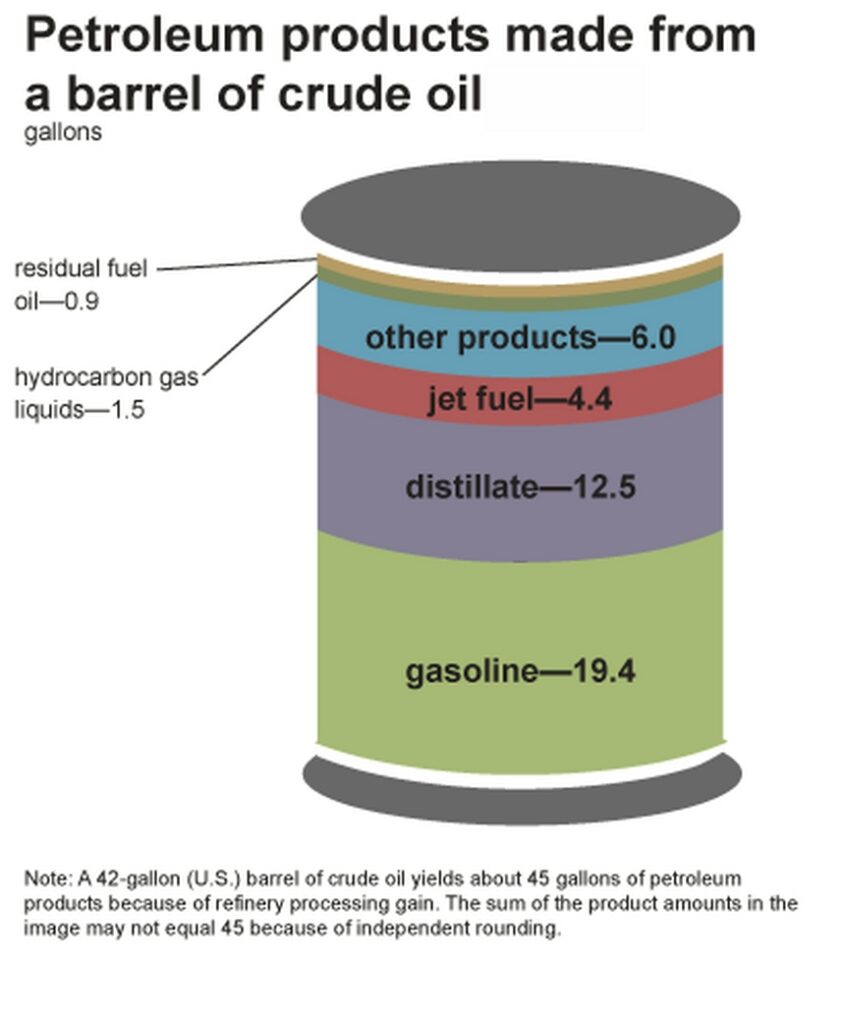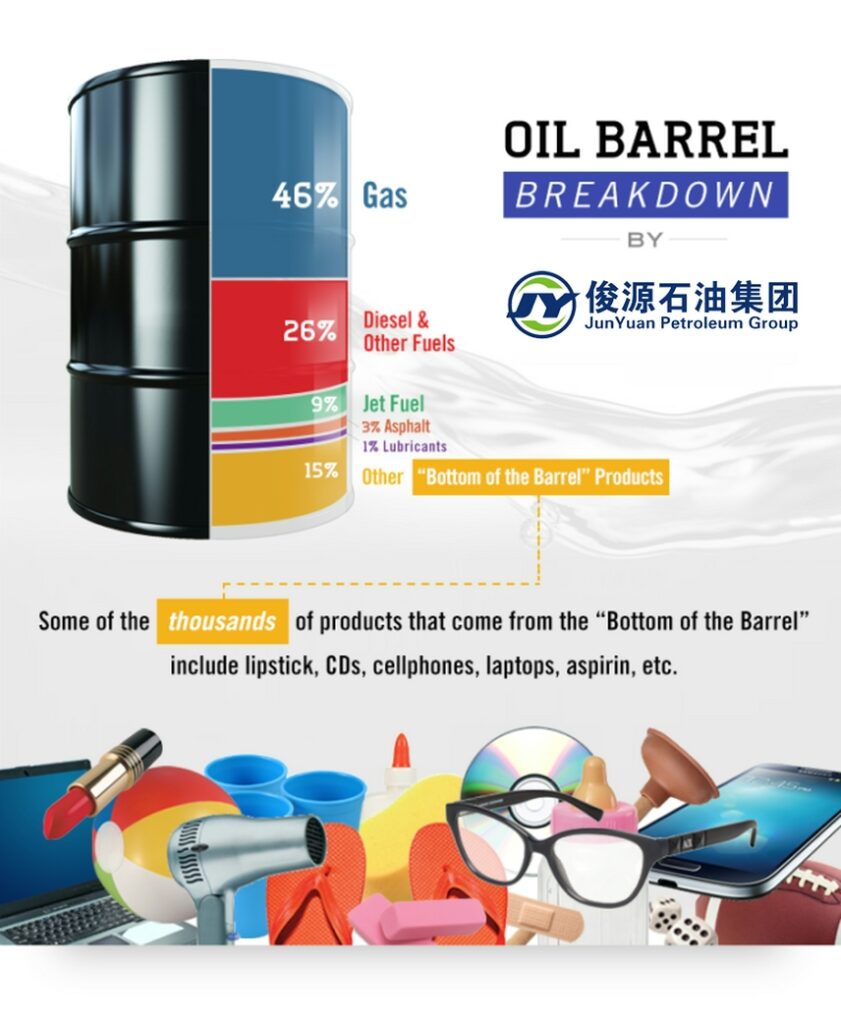What is crude oil and what are petroleum products?
We call crude oil and petroleum fossil fuels because they are mixtures of hydrocarbons that formed from the remains of animals and plants (diatoms) that lived millions of years ago in a marine environment before the existence of dinosaurs. Over millions of years, the remains of these animals and plants were covered by layers of sand, silt, and rock. Heat and pressure from these layers turned the remains into what we now call crude oil or petroleum. The word petroleum means rock oil or oil from the earth.
Crude oil and other hydrocarbons exist in liquid or gaseous from in underground pools or reservoirs, in tiny spaces within sedimentary rocks, and near the earth’s surface in tar (or oil) sands. Petroleum products are fuels made from crude oil and hydrocarbons contained in natural gas. Petroleum products can also be made from coal, natural gas, and biomass.
Products made from crude oil
After crude oil is removed from the ground, it is sent to a refinery where different parts of the crude oil are separated into useable petroleum products. These petroleum products include gasoline, distillates such as diesel fuel and heating oil, jet fuel, petrochemical feedstocks, waxes, lubricating oils, and asphalt. Learn more in Refining crude oil—inputs and outputs
A U.S. 42-gallon barrel of crude oil yields about 45 gallons of petroleum products in U.S. refineries because of refinery processing gain. This increase in volume is similar to what happens to popcorn when it is popped. A corn kernel is smaller and more dense than a popped kernel. The amount of individual products produced varies from month-to-month and year-to-year as refineries adjust production to meet market demand and to maximize profitability.

What’s in a Barrel of Oil? The 42-Gallon Breakdown

Have you ever wondered what, exactly, is in a barrel of oil? It’s certainly not full of monkeys, that’s for sure. The obvious answer, you might be thinking, is 42-gallons of gooey, black crude. And that’s technically correct. However, there is so much more potential in that barrel of oil than fossil fuel alone.
One barrel = 42 US gallons = 159 litres = an abundance of possibilities.
What is crude oil?
First, we’ll start with the basics: what is crude oil? Also known as petroleum, crude oil is a liquid mixture of hydrocarbons, organic compounds, and some small amount of metal found below the earth’s surface. Petroleum is created through the heating and compression of very old organic matter (prehistoric plants and animals) over a long period of time. Crude oil is considered a fossil fuel because it is the natural byproduct of decaying plants and animals.
Over this long period of time, the prehistoric algae, zooplankton, and other organic matter settled to the bottom of ancient bodies of water where it all combined with mud. The pressure from layers of sedimentation exposed the organic matter and mud to high temperatures. Through diagenesis, the chemical composition first turned to a waxy compound called kerogen. Then, with increased heat, the matter turned into a liquid through catagenesis. That liquid is crude oil.
So far, our barrel is full of 50-97% hydrocarbons, between 6-10% organic compounds, and less than 1% metal.
What else is in a barrel of oil?
Untapped possibilities.
Every barrel of unrefined oil also has the potential to be transformed into a number of different products. But before anything can be made, the petroleum must first be refined.
Since crude oil contains various types of hydrocarbons, these need to be separated to form the desired end product (because not all petroleum products are created equally). Fractional distillation occurs when crude oil is heated and the different components of the oil are extracted in stages through their different vaporizing temperatures.
Once refined, crude oil can be transformed into all sorts of useful products, including fuels and other oil-based lubricants.
However, while gasoline production is one of the largest petroleum-based products currently manufactured, gas makes up less than half of a barrel of crude oil.
If gasoline accounts for 46% of our oil barrel, what’s happening to the other 54%?
Let’s break it down for you:
Twenty-six percent of the remaining crude oil goes into the production of diesel and other fuels.
About nine percent is used to make jet fuel.
Three percent of the crude oil goes into the production of asphalt to pave roads and parking lots.
One percent of this goes into the manufacturing of lubricants: the greases and fluids that help keep our world running smoothly.
The remaining fifteen percent is classified as other. These —bottom of the barrel ” petrochemical products include thousands of different items, ranging from makeup to medicine.
In fact, we highlight these —Bottom of the Barrel ” products in our Petroleum Product of the Week series to showcase just how many products we rely on daily are made using petroleum (at some point in the process).
Did you know that aspirin is a petroleum product? How about food coloring and vape juice? If you dress up your smile with some lipstick, your favorite brand might just be a petroleum product, too.
Every time you reach for something plastic or something made from synthetic rubber, you’ve got yourself your very own petroleum product. Glasses? Check. Styrofoam? Check. Toothbrush? Check. Even money contains elements of petroleum.
How much oil do we consume?
This is an incredibly difficult question to answer, to be quite honest. One person’s oil consumption is entirely dependent on another person’s consumption, as well as some random company’s consumption. Oil consumption extends well beyond transportation (even if that’s the biggest consumer of oil).
For some perspective, though, the US consumed approximately 19.7 million barrels of petroleum per day (b/d) in 2016. That same year, motor gasoline consumption averaged about 9.3 million b/d. Even if you could account for how much fuel you consume, there’s difficulty in accounting for how much fuel went into transporting your groceries— or what percentage of a —barrel ” went into manufacturing your t-shirt or dish soap.
Sources:
https://oilprice.com/Energy/Crude-Oil/What-Is-Crude-Oil-A-Detailed-Explanation-On-This-Essential-Fossil-Fuel.html
https://www.eia.gov/energyexplained/index.cfm?page=oil_use
Junyuan Petroleum Group is the largest manufacturer of high purity pentanes, hexanes, heptanes, octanes and specialty solvents in China, serving for the applications of polyethylene, polypropylene, polyurethane, expanded and extruded polystyrene, heat exchange medium for geothermal energy production, catalyst production, vegetable oil extraction, adhesives, paints and coatings, reaction solvent, rubber and tire industry, starter fluid, pharmaceutical industry, organometallic solvent, algal oil extraction and heavy oil and bitumen.
WhatsApp: +86 178 1030 0898
Sales Inquiry: info@junyuanpetroleumgroup.com
Web: www.junyuanpetroleumgroup.com
nHexane #hexane #hexanes #normalhexane
pentanes #pentane #normalpentane
isopentane #pentanedblend #pentaneblends
blendedpentane #isohexane #nHeptane
normalheptane #heptanes #octanes #nOctanes
dsolvents #specialtysolvents #D20Solvent
D20Fluids #Solvents #Solvent #highpurityhexane
highpuritypentane #highpurityisohexane
highpurityisopentane